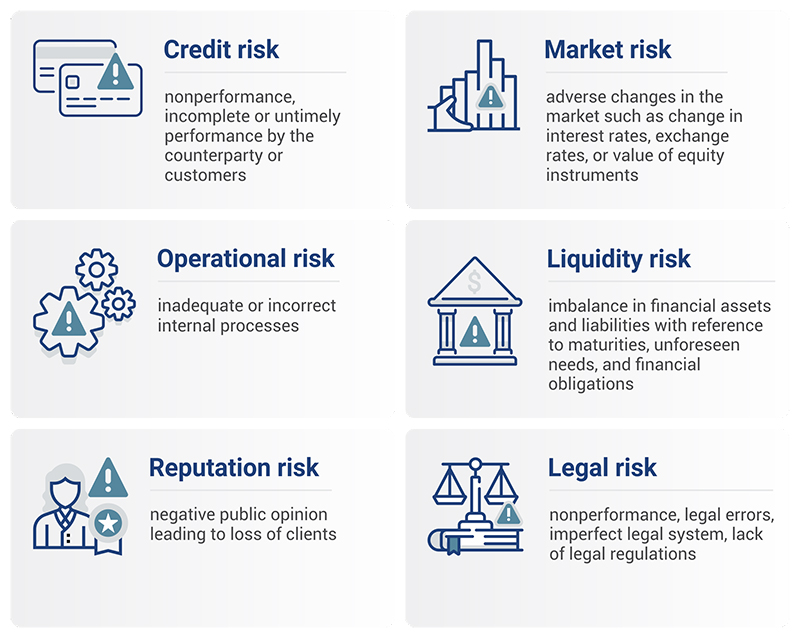
The primary component of the investment bank’s risk management strategy is the risk appetite based on the current and future risk profile, as determined by the Investment Bank’s Council.
Risk management is the identification, analysis, and response to risk factors that are part of a business life cycle. A good risk management structure involves the calculation of uncertainties and prediction of their influence on the business.
When it comes to risk management, investment banks need to focus on two main aspects:
Risk, often viewed negatively, is a crucial factor for optimizing performance. It involves assessing potential deviations from anticipated income, whether absolute or relative to market benchmarks. This divergence, although seemingly negative, is recognized by investment professionals as an expected outcome in return for investment.
The notion that "higher risk yields higher returns" reflects the understanding that in investment banking, increased risks are associated with higher volatility. However, higher risk also brings increased volatility, which can be managed through trial-and-error methods.
The level of volatility an investor or entity can tolerate depends on their risk tolerance and investment goals. Overall, risk management in investment banking involves understanding, assessing, and mitigating risks to align with investment objectives and manage volatility effectively.
Investment banks engage in different types of businesses and as such, each type is associated with a specific set of risks. Depending on their sources and impact, they are grouped as follows.

This is how investment banks can manage risks at different levels.
To mitigate risks like— potential loss risks from market variables like currency rates, inflation, and interest rate fluctuations, investment banks employ various strategies such as hedging, diversification, and portfolio optimization.
Investment banks need to employ a dynamic framework to monitor and manage liquidity, interest rates, foreign exchange, and commodity price risks. Additionally, they must assess vulnerabilities through stress testing, prepare strategies to mitigate potential threats, and strengthen portfolio resilience in volatile market conditions.
These approaches are crucial for investment banks to safeguard against market uncertainties and enhance overall portfolio performance.
Credit risk, the danger of borrower or counterparty default, is a critical concern for investment banks. To mitigate this risk, banks utilize various strategies including—
These techniques collectively help investment banks manage credit risk effectively, safeguarding their financial stability and ensuring the integrity of their lending and trading activities in the market.
The operational risk stems from internal organizational shortcomings or human error, leading to potential loss. Investment banks mitigate this risk through the linear process of risk identification, risk assessment, measurement and mitigation, monitoring, and reporting. Key tips include—
Risks like— the potential financial loss resulting from non-compliance with laws, regulations, or contractual obligations, include exposure to lawsuits, fines, and reputational damage stemming from legal breaches. Mitigating this involves establishing tailored legal risk management programs as part of an institution's overall risk management framework. Additionally, by customizing strategies to the institution's specific needs, legal risk management programs contribute to enhanced risk mitigation and promote responsible corporate conduct.
This occurs when a bank struggles to meet its obligations, endangering its financial stability or existence. It impedes the bank's ability to convert assets into cash without capital loss due to insufficient interest. To mitigate this risk, banks must,
These proactive measures enhance the bank's ability to fulfill short-term obligations, even during financial difficulties.
Reputational risk encompasses potential harm to a bank's brand or image, arising from various sources like individual employee actions or institutional conduct. Unlike other risks, managing reputational risk demands diverse strategies due to its broad causes. To prevent this risk,
By implementing a range of mitigation tactics, banks can safeguard their reputation amidst diverse challenges.
Though the above principles and information are helpful, they may not fully address an investor’s concerns. The risk equation is dependent on how people view gains and losses.
Tversky and Kahneman document that, “investors would put twice the weight on the pain associated with a loss than the good feeling associated with a profit”.
Another behavioral tendency is the ‘drawdown’. The magnitude, duration, and frequency of a negative period are considered while measuring drawdown. Drawdown is the period during which the asset’s return is negative in relation to the previous high mark.
Risk management is closely associated with psychology too!